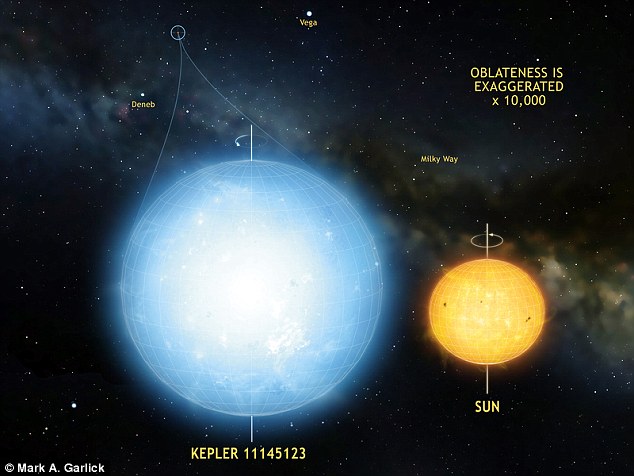Astronomers have hailed the bizarre find of an almost perfectly spherical giant star as an intergalactic record breaker according to Daily mail.
Named Kepler 11145123, the hot and luminous star is more than twice the size of the Sun and rotates three times more slowly than the Sun.
Researchers analysing its rotation were stunned to find the difference in radius between the equator and the poles is only 3 km with a precision of 1 km.
This makes Kepler 11145123 the roundest natural object ever measured, even more round than the Sun’ said Laurent Gizon Research and the, who led the study.
Stars are not perfect spheres.
While they rotate, they become flat due to the centrifugal force.
The groundbreaking research is the first time astronomers have succeeded in measuring the oblateness of a slowly rotating star with unprecedented precision.
The researchers have determined stellar oblateness using asteroseismology – the study of the oscillations of stars.
The technique is applied to a star 5000 light years away from Earth and revealed that the difference between the equatorial and polar radii of the star is only 3 kilometers – a number that is astonishing small compared to the star’s mean radius of 1.5 million kilometers; which means that the gas sphere is astonishingly round.
Gizon and his colleagues selected this star to study because it supports purely sinusoidal oscillations.
The periodic expansions and contractions of the star can be detected in the fluctuations in brightness of the star.
NASA’s Kepler mission observed the star’s oscillations continuously for more than four years.
Different modes of oscillation are sensitive to different stellar latitudes.
For their study, the authors compare the frequencies of the modes of oscillation that are more sensitive to the low-latitude regions and the frequencies of the modes that are more sensitive to higher latitudes.
This comparison shows that the difference in radius between the equator and the poles is only 3 km with a precision of 1 km.
Surprisingly, the star is even less oblate than implied by its rotation rate.
The authors propose that the presence of a magnetic field at low latitudes could make the star look more spherical to the stellar oscillations.
‘We intend to apply this method to other stars observed by Kepler and the upcoming space missions. It will be particularly interesting to see how faster rotation and a stronger magnetic field can change a star’s shape,’ Gizon added.
‘An important theoretical field in astrophysics has now become observational.’
N.H.Kh

